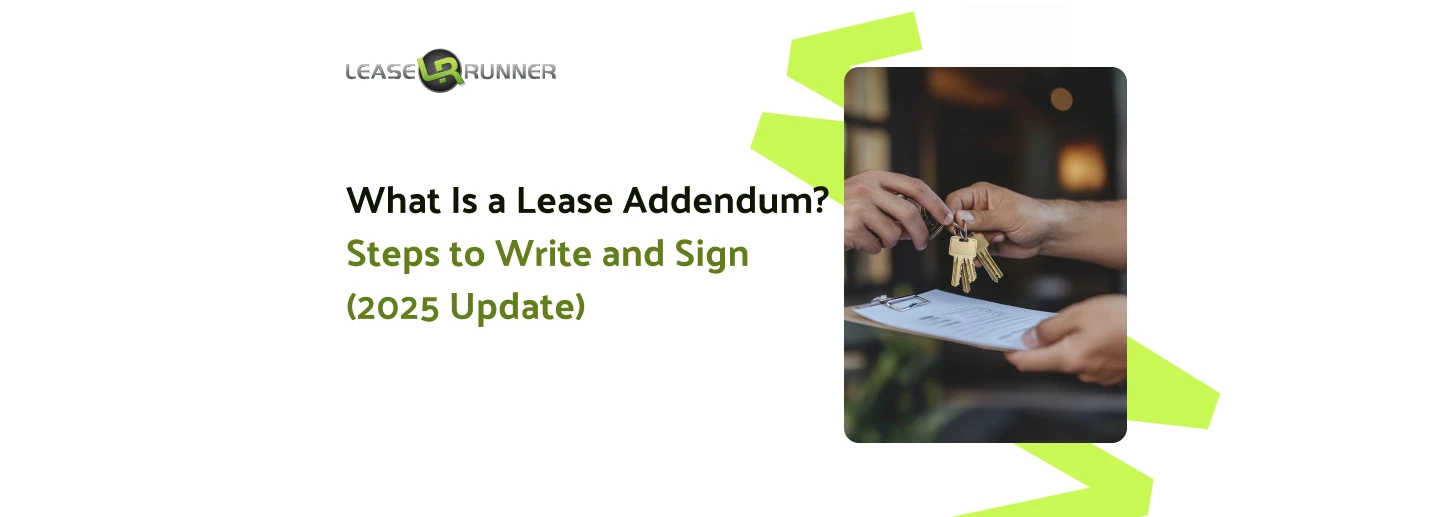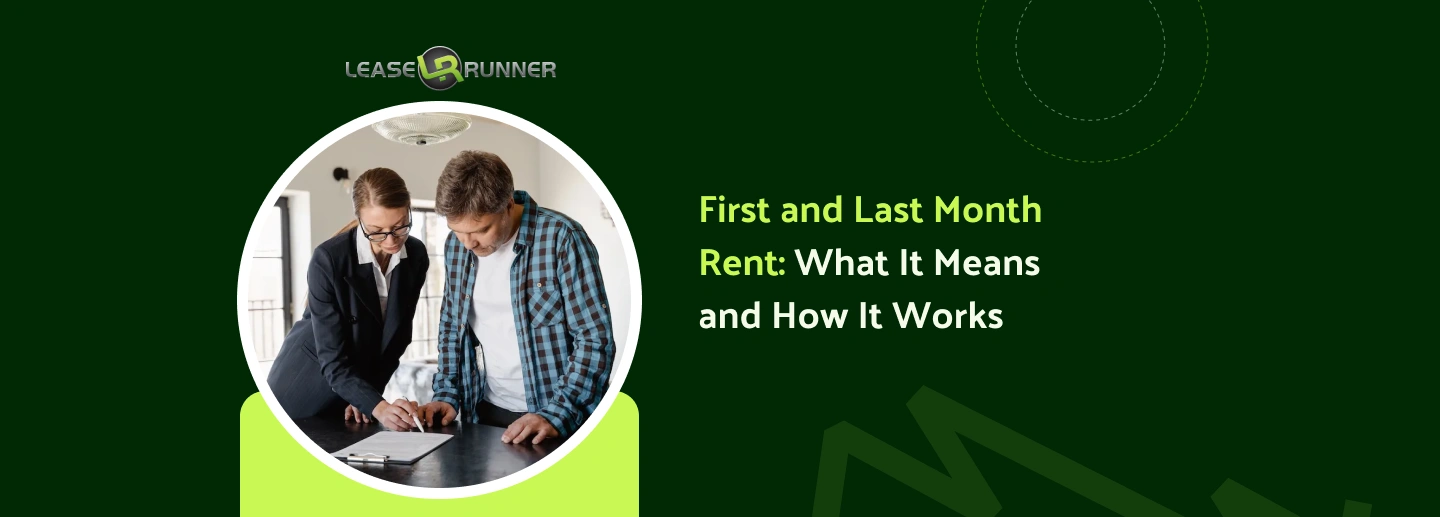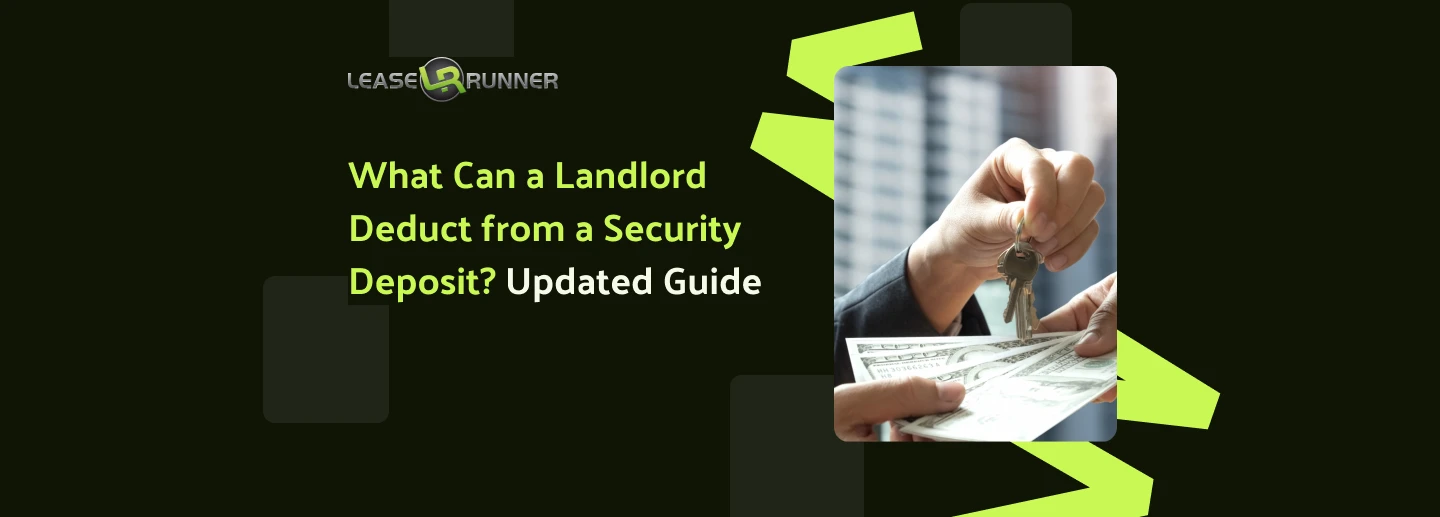Wondering what a lease addendum is and when you might need one? In this 2025 guide, we’ll walk you through the steps to create, write, and sign a lease addendum so you can properly update your rental agreement.
Whether you’re a landlord adjusting property rules or a tenant clarifying your rights, this article provides clear guidance on how to handle changes—such as moving to a month-to-month arrangement—smoothly and legally.

What Is a Lease Addendum?
A lease addendum is a legally binding document that either adds or changes significant information to your current lease agreement. You might dispense the lease addendum's meaning as follows: It is a document that enhances the primary lease.
It does not replace the entire agreement but instead supplements it with new details. This distinction matters because the purpose of a lease addendum is to handle changes in a flexible way without drafting an entirely new contract.
The target audience for lease addenda includes both landlords and tenants. Property owners use an addendum to a lease agreement to maintain compliance, adjust rules, or clarify responsibilities. Tenants, on the other hand, benefit by knowing their rights and obligations remain transparent even when rental terms evolve.
The intended use of an addendum is practical: it allows adjustments without rewriting the entire contract. Common scenarios explain how a lease addendum works:
- Suppose the initial lease does not mention any pet policies, for instance. In that case, the landlord and tenant may subsequently agree on a residential lease addendum incorporating deposits, size restrictions, or breed limitations.
- Similarly, a month-to-month lease addendum may be included to transition from a fixed-term lease to a month-to-month agreement if conditions change, for instance, if a tenant requests more flexible terms.
- In other cases, an additional occupant's lease addendum or a property alterations lease addendum can cover situations like a new roommate joining or a tenant requesting approval to repaint the unit.
To be short, this paper guarantees that both sides have a clear, current knowledge of the lease conditions without changing the whole structure of the original contract.
Is a Lease Addendum Legally Binding?
The answer is yes, once both parties sign. A lease addendum definition refers to an attachment that adds or updates terms within a lease already in force. A court will treat a signed legal addendum to a lease like any other part of the contract.
Take the case of pets. If the original agreement did not mention animals, a landlord can prepare a pet policy lease addendum. That document may set deposits, weight limits, or specific breed restrictions. Once the tenant signs, the terms become enforceable.
The same applies to a property alteration lease addendum, where tenants agree to rules for painting or remodeling. Both sides must consent. Do I have to sign a lease addendum?. Yes, signatures from the landlord and the tenant make it valid.
Good management also requires storage. Keep the addendum to the residential lease agreement with the main contract and renewal files. Organized records support your position in disputes. They work much like a signed lease termination letter template or a non-renewal of lease letter.
Can a Landlord Add a Lease Addendum Without the Tenant’s Consent?
The answer is generally no. For an addendum to be enforceable, all parties must agree to the changes. Here are some key points:
- Mutual Consent Is Necessary: Both parties must sign the document. If only one side agrees, it may not hold up legally.
- Legal Validity: Without consensus, the addendum might be invalidated by a court. Always be cautious and ensure that all modifications receive proper acknowledgment.
- Avoiding Disputes: Attempting to impose changes unilaterally can lead to tension and legal disputes. Open dialogue is essential to settle any modifications.
Therefore, it is evident that mutual agreement is the foundation of any valid lease modification.
Lease Addendum Compared to Other Legal Documents
When people ask what a lease addendum or a rental lease addendum is, the answer rests on comparing it with other tools. The purpose of a lease addendum is to handle updates without writing a fresh lease from scratch.
Different addenda cover different needs, like a tenant addendum, an additional occupants lease addendum, or a lease addendum extension that extends time without altering core terms.
Other legal documents serve separate roles:
- A lease amendment changes whole clauses. For example, changing the rent amount.
- A new agreement replaces everything, often raised in debates on a lease addendum or a whole new lease.
- A clause inside the original contract sets rules from the start, but it is not as flexible.
Sometimes landlords rely on a sample lease addendum or a sample addendum to lease for structure. Still, customization keeps it enforceable. Always confirm what to include in a lease addendum, such as dates, deposits, and conditions for use.
Lease Addendum vs. Lease Amendment
Many confuse the difference between an addendum and an amendment. Both add legal power, but they act differently.
- A lease amendment rewrites the main lease. Imagine rent increases: the clause with the dollar amount is replaced in full.
- An addendum to the rental contract supplements the existing text without deletion. Suppose both parties agree to allow a pet. A pet policy lease addendum describes those terms, while the main rent or utility clauses stay untouched.
Addenda work best for specific or short-term needs. For instance, a lease addendum extension allows a tenant to remain for three months. That avoids creating an entirely new lease. Easy drafting and quicker approval explain why a lease addendum is used in many cases.
Lease Addendum vs. Sublease Agreement
A sublease agreement functions very differently. A sublease occurs when an original tenant rents the home to another person. That separate tenant pays the first tenant, not the landlord. More guidance appears in subletting vs subleasing.
By contrast, an addendum for a rental agreement keeps landlord and tenant tied to one another. If a roommate joins, the landlord issues an additional occupant's lease addendum. Nobody replaces the tenant. Everyone remains bound under the same contract.
Lease Addendum vs. Lease Clause
A clause appears in a contract at the time of signing. It forms part of the base text. An addendum comes later, providing updates as life changes.
For example, if the original lease sets late-fee rules, that is a clause. If fees were not listed, drafting a lease addendum later would cover the missing term. Another example relates to leaving. If the length of the notice period before moving was overlooked, a new addendum can spell it out.
These cases highlight reasons to use a lease addendum. Clauses create the framework. Addenda will keep the deal current after the conditions shift.

Common Types of Lease Addendums
Besides learning “What is a lease addendum about?”, you should also know its common types. Many rental agreements are enhanced by specific addendums tailored to particular issues. Below, we discuss five common types:
Pet addendum
A pet addendum is commonly used in a residential lease addendum context. It details:
- The allowed types and sizes of pets.
- Required pet deposits or fees.
- Specific rules to protect the property from pet-related damage.
Using this addendum ensures that both the tenant and the landlord clearly understand the terms regarding animals on the property.
Smoking addendum
A smoking addendum is another frequent type of addendum to a lease. This document specifies:
- Areas where smoking is prohibited.
- Designated smoking zones, if any.
- Consequences for not following the smoking policy.
This type of addendum helps maintain a healthy and safe environment while being fair to tenants who might be adversely affected by smoke.
Rent Adjustment Addendum
Changes in market conditions or financial arrangements may necessitate a rent adjustment addendum. It explains:
- The new rental amounts and the effective date of the increase or decrease.
- Adjustments to the payment schedule.
- The conditions under which the changes apply.
This addendum clarifies the expectations and financial commitments between the landlord and tenant.
Guest or occupancy addendum
A guest or occupancy addendum is used when limits on the number of occupants or guest stays need to be set. It typically covers:
- Maximum occupancy levels.
- Duration and frequency of guest visits.
- Possible penalties for violation of these limits.
By setting clear rules, this document helps prevent overcrowding and maintains the intended use of the property.
Early Termination Addendum
Life often changes unexpectedly, and a tenant may need to leave early. An early termination addendum explains under what conditions someone can break their lease. It describes fees, notice periods, or special cases such as job relocation, medical emergencies, or military service.
Including an early exit policy helps both landlords and tenants plan realistically. Addenda explain rights and duties in a way that benefits both parties.
Utilities Addendum
In some rentals, landlords must clarify who pays for which utilities. A utilities addendum will spell out who covers water, electric, internet, or trash services. The landlord may use this addendum for transparent billing or to update terms due to rate changes or new laws.
Sublease Addendum
Sometimes a tenant wants another person to move in and pay rent to them. In those situations, a sublease addendum grants or restricts that right. When reviewing a what is a sublease resource, landlords may use this addendum to list approval steps or reasons for denial. This helps prevent lease violations or unapproved subletters.
Crime-Free Housing Addendum
Safety is a priority in any rental. A crime-free addendum bans illegal activity on the property, such as drugs or violence. This helps landlords keep neighborhoods safe and comply with local laws.
Other Useful Addendums (insurance, maintenance, lease extension, disclosures)
Beyond the basics, landlords may need tailored agreements such as:
- An insurance addendum requiring proof of renters’ insurance.
- A maintenance or property alterations lease addendum detailing who handles repairs and upgrades.
- A lease addendum extension that lengthens the stay without creating a new contract.
- Disclosure addendums for lead paint, mold, or other hazards required by local law.
When unsure how to proceed, landlords may review a sample lease addendum. However, customization remains essential because each property carries unique conditions. Guides on how to write a non-renewal of lease letter show why detail matters in legal documents.
Summary Table: Common Types of Lease Addendums
Here is a summary of types of lease addendums you might refer to:
How to Write and Sign a Lease Addendum?

After asking what a lease addendum is, the next step is learning how to actually prepare one. A lease addendum definition makes clear that the addendum is an attachment to an existing lease, not a replacement.
The purpose of a lease addendum is to introduce new rules or update existing terms in a direct, legal way. Unlike writing an entirely new contract, using an addendum to a rental contract saves time while keeping agreements enforceable.
Understanding how a lease addendum works also reduces disputes. Whether a landlord wants to allow pets through a pet policy lease addendum, regulate renovations via a property alterations lease addendum, or approve roommates with an additional occupants lease addendum, the same drafting and signing process applies.
Key elements to include in the lease addendum
Knowing what to include in a lease addendum ensures the document is complete and enforceable. A sample addendum to a lease can provide structure, but customizing is critical. Standard sections usually cover:
- Title and Reference: Label it as "Lease Addendum" and cite the date and title of the original lease so there is no confusion.
- Property Information: State the property's full address, plus the start and end dates of the original lease.
- Parties: Record the names and contact details of both landlord and tenant for clarity.
- Specific Terms Being Updated: Examples include pet deposits, smoking rules, utility responsibilities, or rent increases.
- Binding Language: Add wording that makes the legal addendum to a lease part of the original agreement.
- Signatures: Both parties sign, confirming their acceptance.
Clear writing reduces misinterpretations. Using plain English when drafting a lease addendum avoids disputes later.
How to write a lease addendum?
Before deciding how to add an addendum to a lease, landlords and tenants should review their needs. Some changes require an addendum to the residential lease agreement rather than a full lease amendment. The difference between an addendum and an amendment is important: amendments alter the original text, while addenda supplement it.
When writing, landlords should follow a methodical approach:
- Step 1 - Identify the Need: Perhaps the lease lacks pet rules. Here, a pet policy lease addendum can outline fees, restrictions, and responsibilities.
- Step 2 - Draft in Detail: List clear conditions. For example, in a utilities addendum, specify whether the tenant covers gas, while the landlord pays water and trash.
- Step 3 - Use Bullet Points: Bullet points make each rule easy to read. For instance, an early termination addendum might list notice requirements, penalties, and deposit rules.
- Step 4 - Customize Examples: While templates help, avoid generic wording. A tenant addendum covering extra roommates should use the tenant's name and the new occupant's details. Guidance on occupancy matters prevents disputes that sometimes arise when agreements lack detail.
Additional advice: Minimize legal jargon, but ensure precision. For example, define "guest stays longer than 14 days" rather than vague wording like "extended period."
How to sign and execute a lease addendum?
Then comes the question many ask: Is a lease addendum legally binding, and do I have to sign a lease addendum? The answer is yes. A legal addendum to a lease becomes enforceable only when both landlord and tenant sign. Skipping this step leaves changes open to challenge. Steps for execution include:
- Title and Introduction
Label the document clearly as a "Lease Addendum." Connect it to the original lease by listing the date and title. Example: "Lease Addendum to the Rental Agreement dated March 1, 2023."
- Identify the Parties
Write the full names and contact details of the landlord and the tenant. Include the rental property address and the lease's start and end dates. This context prevents disputes, especially when multiple properties are managed by the same landlord.
- Detail the Changes
Use bullet points for clarity. Example changes:
- Rent increases of $50 per month, effective June 1.
- Smoking is limited to the outdoor balcony only.
- Tenant may add one roommate through an additional occupant's lease addendum.
- Permission for repainting under a property alterations lease addendum.
- Using examples illustrates how a lease addendum works in real life.
- Legal Language and Signatures
State that the addendum forms part of the lease. Example: "This Addendum is legally binding and incorporated into the Lease Agreement dated March 1, 2023." Provide signature lines for landlord, tenant, and date. Without signatures, the addendum is not enforceable.
- Future Amendments
Explain procedures for new changes. For example, a clause stating, "Any future updates must be made in writing and signed by both parties." This prevents one side from claiming verbal agreements as binding.
Practical Legal Considerations for Landlords
There are legal obligations to running rental properties that need to be handled correctly. Understanding the lease addendum meaning helps landlords update agreements without rewriting entire contracts. Examples of this include:
Legal Obligations and Disclosure:
Landlords must obey federal, state, and local rules. These include safety laws and tenant privacy. Ignoring rules can cause fines or make leases invalid. Checking laws regularly ensures the addendum to residential lease agreement stays legal and enforceable.
Draft Clear and Specific Lease Terms:
Use plain terms when drafting a lease addendum. For example:
- A pet policy lease addendum that defines allowed animals and deposit amounts. For clarity on deposits versus fees, landlords can see guidance on pet fee vs pet deposit.
- An additional occupants' lease addendum or tenant addendum for new roommates and guest limits. Landlords can consult recommendations on multiple tenants on a lease for best practices.
- A property alterations lease addendum explains what tenant changes are allowed.
Ensure Proper Execution and Documentation:
Both landlord and tenant must sign every lease change. A signed addendum or renewal is legally binding. Store all papers safely. For lease renewals, the rules are clear and can be found in How to Renew a Lease Agreement.
Honor Tenant Rights and Fair Housing Laws:
Fair housing laws protect against discrimination. Landlords cannot refuse service animals, even if the rental prohibits pets. Respect the reasonable terms of tenancy, rent, and occupancy, so you will be informed of complaints.
Follow Legal Eviction Protocol:
Evict for only legal reasons like non-payment of rent or a breach of lease terms. Give a written notice, explaining the problem and how much time the tenant has to fix it. If the tenant ignores the written notice, you can file to evict the tenant with the court. Following this procedure will protect the landlord's rights.
Understanding how a lease addendum works shows the purpose of a lease addendum: to keep documents current, avoid disputes, and protect rights.
Conclusion
In summary, knowing deeply “What is a lease addendum?” and carefully drafting one offers an effective method for updating your rental contract. Without redrafting the whole lease, it allows both sides to include changes, about pet policy, smoking rules, or switching to a month-to-month lease addendum.
Clear language, mutual consent, and proper documentation are key to ensuring its enforceability. For more information regarding this topic, feel free to check the LeaseRunner blog site!
FAQs
Q1. When should a lease addendum be used?
It should be utilized when new policies or clarifications, such as changes in pet restrictions, smoking laws, rent adjustments, or switching to a month-to-month agreement, call for action without renegotiating the whole lease.
Q2. What are the key elements of a legally binding addendum?
Essential are a clear title, a thorough explanation of changes, identification of all the parties, and appropriate legal language with slots for signatures.
Q3. What is the purpose of an addendum?
The main purpose of an addendum is to update or add terms to an existing lease without rewriting the entire contract. It helps landlords and tenants adapt to new situations, such as pets, rent changes, or added occupants, while keeping the original lease valid. An addendum ensures clarity, legal protection, and flexibility for both parties.
Q4. What is addendum meaning on a lease?
On a lease, an addendum means a legally binding attachment that supplements the existing rental agreement. Instead of replacing the lease, it adds specific terms, like rules about smoking, property alterations, or a lease extension. In short, the addendum becomes part of the contract and defines important updates that both the landlord and tenant agree to follow.







